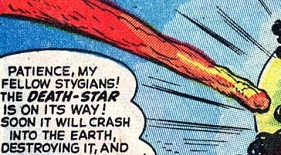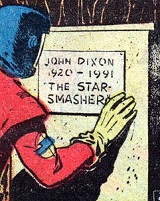 History:
History:

STYGIANS
Classification: Alternate Reality (Reality-5106) humanoid extraterrestrial
Location/Base of Operations: Planet Stygia, also a Stygian planetoid "continent"
Known Members: None
Affiliations: None
Enemies: Humans (notably John Dixon)
First Appearance: Space Squadron#1/3 (June, 1951)
Powers/Abilities: The Stygian civilization is very advanced
and long-lived. Stygians have mastered magnet technology
over stellar objects to the point they can stop an object
traveling at 50 billion miles per minute (over four times the speed of
light) and can exactly direct stellar objects over vast distances (such as the Death-Star).
Stygians apparently have cloaking technology for their warp-capable
space vehicles. They claim to have strong lungs that can withstand
harsh chemical atmospheres (although their large proboscis may help
filtering out impurities).
Traits: Stygians are arrogant and
self-confident with a superiority complex over other species. They
enjoy parading their advanced technology to aliens, but seek awe and
terror from them in their merciless approach to the slaughter of their
victims to maintain regional space dominance.

Type: Humanoid
Eyes: Green/black
Fingers: Five (with opposable thumb) (approximately two-thirds
length of a standard adult human)
Toes: Unrevealed
Skin color: Green
Average height: 5'9" (haunched)
 History:
History:
(Space Squadron#1/3 (fb) - BTS) - Stygians live on a
planet far beyond Earth's solar system. They mastered magnetic
technology to the extent they could induce exact targeted movement in
stellar objects, including small stars. The long-lived Stygian
civilization monitored nearby star systems and were aware of Earth for
100 million years, but felt threatened by the presence and rapid
technological advancement of humans. With humans entering and exploring
space, Stygians resolved to destroy humankind by obliterating Earth,
using a small magnetically induced star--a "Death-Star"--traveling at
sub-light speed to hit Earth. Stygia set off a planetoid "continent"
(apparently cloaked) into Earth's solar system that would obscure the
Death-Star's approach from Earth's sensors and observation.
(Space Squadron#1/3 (fb)) - In late 1952, human test pilot John Dixon blasted off in an atomic-powered rocket plane into space and collided with the Stygian planetoid base. The Stygians rescued him from the bleak surface, providing a helmet that protected him from the local atmosphere. The aliens took him to their laboratory and gloated to Dixon over their plan to destroy Earth. But the quick-thinking test pilot manipulated the Stygian leader by claiming humans were smarter than Stygians. The leader hoped humans would panic with impending disaster set to occur in early 1955, and they released Dixon to return home.
Dixon reached Earth and soon convinced
the American Government to direct resources to find a way to stop the
Death-Star. Dixon led the team that set a powerful bomb into the path
of the star. The massive explosion shattered the Death Star, scattering
debris across space with one large piece smashing into the Stygian
planetoid, ending the immediate alien threat.
Comments: Created by uncredited writer & George Tuska.
Derived from the word Styx from the Greek underworld river, "Stygian" means dark and gloomy, suggesting the nature of their home planet.
Space Squadron describes space a
little differently,
perhaps unique to that reality; "galaxy" refers to the solar system
and nearby space objects, while "universe" relates to the galaxy
(although at one point, the Stygian leader declares they will rule "the
universe of the galaxy!" -- presumably meaning all of the galaxy). And
the Stygians' space-roving "continent" is shown as a small barren
planetoid with (apparently) natural features like small mountains.
Distances and speeds seem to be
fairly arbitrary; I suspect just big numbers for 'wow' factor without
consistency or scientific considerations. Google would've been great
for early scifi writers.
Thanks to the Grand Comics Database
for assistance with credits.
Profile by Grendel Prime.
CLARIFICATIONS:
Stygians have no known connections to:

The Death-Star was a small star weaponized
by the nefarious Stygians, who used their powerful magnet technology to
direct its motion to target Earth at near light speed with impact
scheduled for February 1955. It appeared as a fiery comet. But 2.5
years earlier, human
space explorer John Dixon by chance crashed into a roving Stygian
planetoid base in Earth's solar system. The Stygian leader gloated
about their plan to Dixon, who returned to Earth and helped direct
efforts
to destroy the Death-Star. A powerful atomic bomb was placed in the
Death-Star's path and caused it to explode, scattering its
debris into space. One chunk impacted the Stygian planetoid before the
aliens could escape. Another piece crashed into planet Mercury. Many
years later, Dixon was buried at the base of the Death-Star
mound on Mercury.
--Space Squadron#1/3


Born in 1920, John Dixon became a test pilot for
the US Army. In 1952, he blasted into space in an experimental atomic
rocket plane but crashed into a black planetoid (apparently cloaked)
used by
nefarious Stygian extraterrestrials. They saved him from the toxic
atmosphere with a helmet and explained their mission to eliminate the
threat of the now-spacefaring exploratory human race by obliterating
Earth in 1955 using a speeding magnet-influenced Death-Star. Dixon
manipulated
the Stygians to release him and he returned to Earth. He quickly
persuaded the American Government to direct their resources to
developing a weapon to stop the Death-Star and in February 1955, led
the mission that placed a powerful atomic device in the path of the
star. The Death-Star exploded, saving the Earth and ending the threat
of the nearby Stygians. Dixon's name became legend, nicknamed the "Star-Smasher", and in 1987, he
became the first human to touch Mercury's soil. He died in 1991 and,
as
he had requested, he was buried under a fragment of the Death-Star that
had impacted Mercury decades earlier.
Years later (in 2000), his great
grandson, Captain "Jet" Dixon of Space Squadron, traveled to Mercury on
the anniversary of the Death-Star's destruction to pay respect at John
Dixon's grave.
--Space Squadron#1/3
images: (without ads)
Space Squadron#1/3, p4, pan2 (main image, side view)
p5, pan4 (headshots)
p3, pan5 (3 on planetoid landscape)
p1, pan1 (Death-Star)
p4, pan1 (Dixon)
p2, pan7 (Dixon's grave marker)
Appearances:
Space Squadron#1/3 (June, 1951) - uncredited writer, George Tuska
(pencils & inks), Stan Lee (editor)
First Posted: 10/19/2023
Last updated: 10/19/2023
Any Additions/Corrections? please let me know.
Non-Marvel Copyright info
All other characters mentioned or pictured are ™ and
© 1941-2099 Marvel Characters, Inc. All Rights Reserved. If you
like this stuff, you should check out the real thing!
Please visit The Marvel Official Site at: http://www.marvel.com
Special Thanks to www.g-mart.com for hosting the Appendix, Master List, etc.!